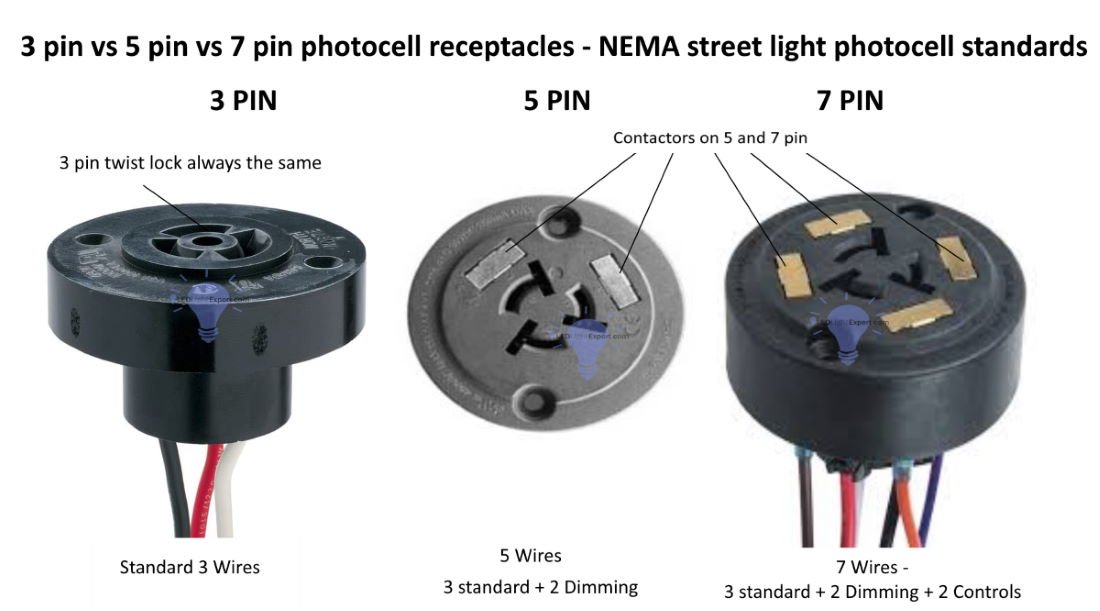
3 PIN VS 5 PIN VS 7 PIN PHOTOCELL RECEPTACLES – NEMA STREET LIGHT PHOTOCELL STANDARDS
Photo from LEDLightExpert
Originally Posted On: https://www.ledlightexpert.com/3-pin-vs-5-pin-vs-7-pin-photocell-receptacles–NEMA-street-light-photocell-standards_b_123.html
What are NEMA photocell receptacles
On the top of most street lights or parking lot lights is a blue or black round knob that is actually used as a lighting control device. The most common lighting control is a dusk to dawn or photocell device. The receptacle can be used for dusk to dawn sensors, but also for advanced DALI / Bluetooth controls. The 3, 5 and 7 pin standard are set by NEMA and are standard in the lighting industry across all manufacturers. They are all the same 3 pin twist lock system so they are easily swapped out. The 5 pin and 7 pin add some additional features.
If you have an outdoor lighting fixture with a receptacle but want to turn it on or off with a switch or use another control instead of the photocell, there is an easy fix. The sensor can easily be swapped with a shorting cap or bypass cap outfitted with the same 3 prongs to bypass the sensor.
3 pin vs 5 pin vs 7 pin photocell receptacles
How do you choose what is right for you? 3 pin photocell receptacles are extremely common and fine for most unless you need to do more advanced controls. 3 pin are beginning to be replaced by 5 and 7 pin receptacles in more advanced light fixtures. The question is why and what is the benefit? That’s what we are here to tell you. Lets start with a breakdown of each receptacle so you understand the differences in them.
3 Pin Receptacle
A 3 Pin receptacle has simply 3 connections. As you can see in the picture, there is slots for the photocell prongs to be inserted to make connections. This connects your hot input power to the photocell and the output from the photocell to what is typically your light fixture along with the neutral wire, so 3 connections. Once it gets dark, that photocell allows the input power to head straight to your fixture through the output side of the receptacle and voila, your light is on.

5 Pin Receptacle
A 5 Pin receptacle is the exact same as 3 Pin receptacle except that in addition it has 2 contacts on the surface of the receptacle. These contacts will have an additional 2 wires on the reverse side of the receptacle which would typically be used to connect to 0-10V dimming leads on an LED driver but could be used for other sensors inside a fixture housing that the receptacle is mounted on.
 7 Pin Receptacle
7 Pin Receptacle
Just like a 5 Pin receptacle, a 7 Pin receptacle still has the original 3 sockets of the standard 3 pin receptacle but has 4 additional contacts on the surface of the receptacle and in turn 4 wires on the reverse side. This allows connection to 0-10V dimming along with other sensors in a sensor housing.
Why choose a 5 or 7 pin?
Most outside lighting jobs work just fine with a standard photocell to turn the light on at night and back off in the morning, the times are changing and so are regulations. Dimming controls, occupancy sensors and more are becoming the standard in many areas to meet regulations to reduce power consumption. Smart controls are becoming more popular and widespread and taking a big part in helping with the reduction of power usage. With the addition of 5 and 7 pin photocell receptacles, dimming, occupancy sensors, monitoring sensors and more can be managed externally with a controller that simply plugs into the top of your fixture like a photocell. No more running wires down a pole and back to a dimming switch and separate controllers to manage different sensors in your fixture. Many municipalities are using smart lights to track lighting around the city to monitor consumption, outages and more. And while this is all the rage in municipalities for smart street lighting right now, it has plenty of applications as technology continues to progress. The future of lighting (as is many industries) is in smart controls. The ability to simply control power and dimming externally simply by plugging a controller into a photocell receptacle turns what could be a huge wiring job and a mess with controls into a simple twist lock and then connect to an app on a smart phone. With wireless and mesh networks out there, you can see why cities are turning to this to control lighting. They upgrade lighting, reduce labor on the upgrade, get more visibility through sensors and reduce power usage, wins all around.
And if you don’t want to deal with the fuss, you can still just plug in a standard 3 prong photocell or bypass cap and pretend you’ve never even heard of a 5 or 7 pin photocell receptacle at all.
